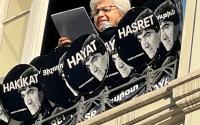9 October 2006The Independent
The number of US troops being wounded in Iraq is now at its highest level for two years as American forces are confronted by increasing sectarian violence and a continuing insurgency.
Figures released by the Pentagon show that 776 soldiers were wounded in action in Iraq last month.
The September figure represents the fourth largest casualty rate since the US and UK invasion in the spring of 2003 and the largest since November 2004 when US forces were involved in a major offensive to clear the city of Fallujah. Some experts believe the number of wounded provides a better insight to the nature of the conflict in Iraq than the figure of 2,700 killed because - in relation to previous wars - many more wounded troops survive.
The ratio of wounded to killed is 8 to 1, compared with 3 to 1 during the Vietnam War. Anthony Cordesman, of the Centre for Strategic and International Studies, told The Washington Post: "These days wounded are a much better measure of the intensity of the operations than killed."
The release of the figure came as violence yesterday continued to rock Iraq. US and Iraqi forces were involved in clashes with Shia militia in the southern city of Diwaniyah for the second time in as many months. The US claimed about 30 militia fighters were killed during the operation to secure a "high value" target.
On Saturday two more US soldiers were killed, bringing the overall death toll to 2,741.
Military experts say the increasing toll of wounded US troops may in part be explained by a shift in their duties in recent months - with thousands being moved into Baghdad in an effort to stop the killing of civilians by rival Sunni and Shia factions.
US commanders have asked for 3,000 Iraqi troops to bolster their presence but so far have received only a few hundred.
Michael O'Hanlon, of the Brookings Institution in Washington, told The Washington Post: "The Baghdad security plan and the spiral of operations is driving us to be more active than we have been in recent months. "We have more people on patrols and out of base so we get more people hurt and killed."
At the same time, other figures show that the number of attacks against US forces is continuing to rise. In July a total of 2,625 explosive devices were encountered by US forces - with the devices either exploding or defused - compared with 1,454 in January. The increase suggested that despite the killing in June of Abu Musab al-Zarqawi, the leader of al-Qa'ida in Iraq, the anti-American insurgency is intensifying.
A spokesman for the American military in Baghdad, Lt Col Jonathan Withington, said: "Attacks against the coalition have definitely increased as the enemy is trying to come in and re-establish themselves. There's a lot of weapons in Baghdad."
In Diwaniyah, the US military said they came under attack from 10 teams of militia fighters armed with rocket- propelled grenades. A US M1A2 Abrams tank was struck by multiple rounds and was severely damaged.
The US soldiers were carrying out an operation to capture a target suspected of involvement in the killing Iraqi soldiers on 28 August.
The US and Iraqi operation focused on the house of Kifah al-Greiti, a commander of the Mehdi Army, a militia loyal to the Shia cleric Muqtada al-Sadr. But Iraqi police sources said Mr Greiti was not arrested and it was unclear who the main target of the operation was.
Fadhil Qasir, a spokesman for the Mehdi Army, told the Associated Press: "They have tried to arrest [Mr Greiti] several times before and they failed this time also."
In recent weeks there has been a marked increase in US efforts to combat the Mehdi Army. American troops have been involved ina series of raids against Mehdi Army their leaders in Baghdad and elsewhere in an attempt to help quell the violence.






